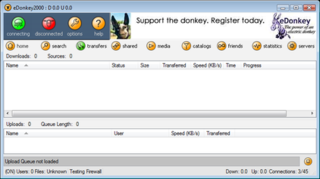Uploading refers to transmitting data from one computer system to another through means of a network. Common methods of uploading include: uploading via web browsers, FTP clients], and terminals (SCP/SFTP). Uploading can be used in the context of clients that send files to a central server. While uploading can also be defined in the context of sending files between distributed clients, such as with a peer-to-peer (P2P) file-sharing protocol like BitTorrent, the term file sharing is more often used in this case. Moving files within a computer system, as opposed to over a network, is called file copying.

eDonkey2000 was (is) a peer-to-peer file sharing application developed by US company MetaMachine, using the Multisource File Transfer Protocol. It supported both the eDonkey2000 network and the Overnet network.
BitTorrent, also referred to as simply torrent, is a communication protocol for peer-to-peer file sharing (P2P), which enables users to distribute data and electronic files over the Internet in a decentralized manner. The protocol is developed and maintained by Rainberry, Inc., and was first released in 2001.

BitComet is a cross-protocol BitTorrent, HTTP and FTP client written in C++ for Microsoft Windows and available in 52 different languages. Its first public release was version 0.28. The current BitComet logo has been used since version 0.50.

Magnet is a URI scheme that defines the format of magnet links, a de facto standard for identifying files (URN) by their content, via cryptographic hash value rather than by their location.
In file sharing, super-seeding is an algorithm developed by John Hoffman for the BitTorrent communications protocol that helps downloaders become uploaders more quickly, but it introduces the danger of total seeding failure if there is only one downloader.
A BitTorrent tracker is a special type of server that assists in the communication between peers using the BitTorrent protocol.
In computing and specifically in Internet slang, a leech is one who benefits, usually deliberately, from others' information or effort but does not offer anything in return, or makes only token offerings in an attempt to avoid being called a leech. In economics, this type of behavior is called "free riding" and is associated with the free rider problem. The term originated in the bulletin board system era, when it referred to users that would download files and upload nothing in return.

Pando was an application which was mainly aimed at sending files which would normally be too large to send via more "conventional" means. It used both peer-to-peer and client-server architectures and was released for Windows and Mac OS X operating systems.
Peer exchange or PEX is a communications protocol that augments the BitTorrent file sharing protocol. It allows a group of users that are collaborating to share a given file to do so more swiftly and efficiently.

eMule is a free peer-to-peer file sharing application for Microsoft Windows. Started in May 2002 as an alternative to eDonkey2000, eMule now connects to both the eDonkey network and the Kad network. The distinguishing features of eMule are the direct exchange of sources between client nodes, fast recovery of corrupted downloads, and the use of a credit system to reward frequent uploaders. Furthermore, eMule transmits data in zlib-compressed form to save bandwidth.

qBittorrent is a cross-platform free and open-source BitTorrent client written in native C++. It relies on Boost, OpenSSL, zlib, Qt 6 toolkit and the libtorrent-rasterbar library, with an optional search engine written in Python.

Tribler is an open source decentralized BitTorrent client which allows anonymous peer-to-peer by default. Tribler is based on the BitTorrent protocol and uses an overlay network for content searching. Due to this overlay network, Tribler does not require an external website or indexing service to discover content. The user interface of Tribler is very basic and focused on ease of use instead of diversity of features. Tribler is available for Linux, Windows, and OS X.
The following is a general comparison of BitTorrent clients, which are computer programs designed for peer-to-peer file sharing using the BitTorrent protocol.
A seedbox is a high-bandwidth remote server for uploading and downloading of digital files from a P2P network. The bandwidth ranges generally from 100 Mbit/s to 20 Gbit/s. After the seedbox has acquired the files, people with access to the seedbox can download the file to their personal computers.

libtorrent is an open-source implementation of the BitTorrent protocol. It is written in and has its main library interface in C++. Its most notable features are support for Mainline DHT, IPv6, HTTP seeds and μTorrent's peer exchange. libtorrent uses Boost, specifically Boost.Asio to gain its platform independence. It is known to build on Windows and most Unix-like operating systems.
In the BitTorrent file distribution system, a torrent file or meta-info file is a computer file that contains metadata about files and folders to be distributed, and usually also a list of the network locations of trackers, which are computers that help participants in the system find each other and form efficient distribution groups called swarms. Torrent files are normally named with the extension .torrent.
Torrent poisoning is intentionally sharing corrupt data or data with misleading file names using the BitTorrent protocol. This practice of uploading fake torrents is sometimes carried out by anti-infringement organisations as an attempt to prevent the peer-to-peer (P2P) sharing of copyrighted content, and to gather the IP addresses of downloaders.
File sharing in Japan is notable for both its size and sophistication.

In computing, and specifically peer-to-peer file sharing, seeding is the uploading of already downloaded content for others to download from. A peer, a computer that is connected to the network, becomes a seed when having acquired the entire set of data, it begins to offer its upload bandwidth to other peers attempting to download the file. This data consists of small parts so that seeds can effectively share their content with other peers, handing out the missing pieces. A peer deliberately chooses to become a seed by leaving the upload task active once the content has downloaded. The motivation to seed is mainly to keep the file being shared in circulation and a desire to not act as a parasite. The opposite of a seed is a leech, a peer that downloads more than they upload.






